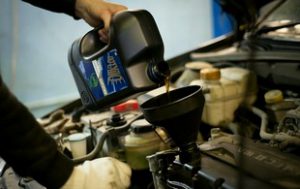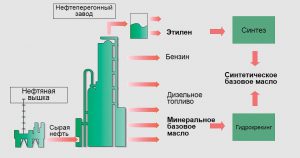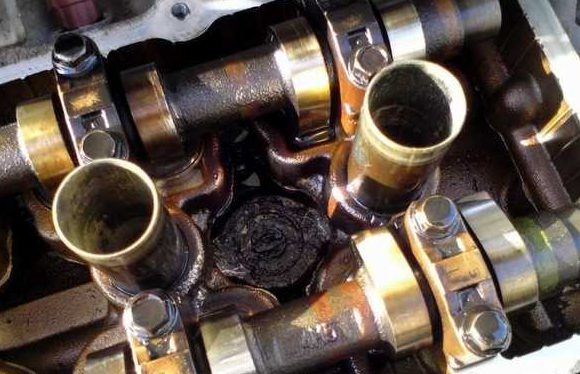Mineral Motor Oils: Characteristics and Features
Each responsible driver knows that motor oil plays a paramount role and has a big impact on the engine. The power unit consists of a large number of parts, which in the process of operation are subjected to serious loads, both mechanically and temperature.
As for the oil, the lubrication fluid forms a protective film on the conjugate surfaces, allowing you to avoid dry friction and accelerated wear. Also, the lubricant performs the washing function, and also cools the surfaces of the parts in the friction zone.
The choice of engine oil is wide enough, today you can find a large number of different products. At the same time, oils are mineral ,. Also in some cases, the synthetic is made to additionally divide on completely synthetic PJSC oils and hydrocracking.
Let us consider in more detail what mineral oil for the engine, characteristics and differences of this product from other analogues. Also in this article we will talk about what advantages and disadvantages have "mineral water" compared with semi-synthetic or synthetic lubricants.
Read in this article
What oil in the engine is better to fill

First of all, we immediately draw your attention to the fact that the best oil for the engine will be a lubricant that is suitable for a specific ICE, taking into account all tolerances and recommendations of the car manufacturer. Such recommendations are separately spelled out in the instruction manual.
We go further. It is important to understand that any engine oil is a basic oil base, which adds a package of additives to ensure the necessary operational properties and characteristics. Such a base can be both mineral and synthetic. The semi-synthetic is actually a mixture of mineral and synthetic bases in a certain proportion.
Regardless of which the basis was used, the engine oil, first of all, should be well hammering through the cold start, as well as the oil film should remain stable under high loads and temperatures. Also, the oil should protect the parts not only from wear, but also from corrosion, to have the ability to "wash" the engine from the inside and not lose the stated properties throughout the service life.
Pros and Cons Mineral Oil For Engine

As for mineral oil, a feature is that this product is natural. In other words, the mineral base is obtained from oil by distillation and purification. This technology of manufacturing engine oil is the simplest, as a result of which mineral oil is characterized by the most affordable price compared to semi-synthetic, hydrocracking or synthetic lubricants.
Mineral oil oils form a stable oil film, which is characterized by good stability. You should also select the ability to delicately clean the engine parts from various sediments and contaminants. Mineral oil, like any other, contains a package of active additives, which improve the anti-wear and detergent properties of lubrication, protect the engine from corrosion, neutralize by-products of fuel combustion, etc.
The main disadvantage of "mineral water" is considered to be the fact that in conditions of reduced temperatures, the viscosity of mineral oil changes largely. Simple words, in frosts, such a lubricant becomes too thick and.
As a result, the engine becomes difficult to start, as the starter is "hard" to scroll into the thickened lubricant. Also, after starting, the viscous lubricant does not enter the details in full, which becomes the cause of strong wear of the force aggregate.
Also, after the outlet of the motor on the operating temperatures of the additive added to the mineral base, quickly burn out and are triggered. This means that such oil makes faster and loses its properties. In other words, the service life of mineral oils is noticeably smaller than synthetics and semi-synthetics, such a lubricant must be changed more often.
Synthetic and hydrocracking: what you need to know


Now let's take a look at the properties of synthetic oils to compare them with mineral. Let's start with the fact that such products are manufactured on a special and sufficiently complex technology. We also note, in the case of hydrocracking (HC), oils are often positioned as synthetic, but it is not quite so.
In fact, hydrocracking oil is also made of oil, but it passes complex processing, which allows the initially natural base to bring to the synthetic as a molecular level as possible.
If we talk about clean synthetics (PAO oil), this is a product of high-tech synthesis of base oil from ethylene gas. As a result, the oil PJSC largely has the best characteristics relatively with basic mineral lubricants, as well as superior hydrocracking products.
In other words, in the cold the fluidity remains, when heated, such a lubricant does not fade, antifriction properties are also improved, an increased service life is noted and a smaller tendency to oxidation and aging.
If simply, the operational characteristics of synthetics are preserved longer, the lubricant material of this type is not afraid of both low temperatures and high heating.

Taking into account the above information, it may seem that the optimal option is the basis of the base. Please note, in many cases, even for modern engines there is no need to pour completely synthetic engine oil. Moreover, for some OBS, this lubricant is not suitable at all.
The fact is that the need to use pure synthetics occurs only when:
- malious oil prescribes the manufacturer of the power unit itself;
- the engine is operated under conditions of extremely low temperatures;
- the motor is constantly experiencing strong loads, works in high speed modes, etc.
In other cases, if in the winter period, the temperature does not fall below -30 degrees Celsius, it is quite possible to pour hydrocracking, with a decrease in temperature, the semi-synthetic is suitable, up to -15 can also be used by high-quality "mineral water".
By the way, if the engine already has a certain wear, and the mileage is about 120-150 thousand km., Instead of "liquid" synthetic or hydrocracking in a summer period or, taking into account the "soft" winter, many use semi-synthetic or even mineral base.
First of all, if the engine is worn, the increased fluidity of the synthetic oil often leads to the fact that. Also, low-viscosity oils form a stable but thin oil film. Motor on such oil can be stronger.
The pressure in the lubrication system may also be low, arises oil starvation and a vehicle breakdown. For this reason, mineral oil for engines with mileage or semi-synthetic is preferable. We also add that synthetics more aggressively brushes the engine, flushing deposits with parts. As a result, the risk increases the oily canals. Mineral oils "wash" the motor slower and make it in stages, holding back in itself washed sediments, which are then output from the engine when the oil is replaced.
Let's summarize
As can be seen, for many motors, high-quality semi-synthetic or mineral oil is quite suitable. Moreover, many drivers note that even from the factory, some automakers are often poured into the mineral water engine, and not expensive synthetics.
For example, this situation is observed with Japanese cars, which are also operated on the territory of Japan. Technological and enough forced Japanese engines are quite normally working on mineral and semi-synthetic oil, as the climate of this country (the absence of frosty winters) allows you to use such lubricants in ICC with the preservation of the planned.
As for the CIS countries, to the issue of oil selection, it is necessary to approach differentially, that is, to take into account the individual features of the operation of the vehicle (make a correction to the oil change intervals, fuel quality, degree of temperature decrease in the winter period, etc.). We also add that in Europe, the United States or Japan, the synthetic oil, on average, can be changed every 20 or even 25 thousand km. The cheaper "mineral water" is also quite capable of going to 10 thousand.
It is important to understand that in the CIS Low Quality Fuel often "kills" any oil is much earlier than the stated period, both mineral and high-quality synthetics. This means that expensive synthetic lubricant in our conditions will still need to drain the maximum after 13-15 thousand km., Mineral oil is desirable to replace in 5-6 thousand, semi-synthetic after 7-8 thousand km, hydrocracking with difficulty reaching up to 10 thousand
It turns out if the manufacturer allows the use of mineral oil in the engine, it may be the most rational choice of quality ratio and price. The main thing is to change such lubrication on time. Finally, we note that when buying lubricants for engine, transmissions and other nodes ,.
Read also
How to choose how to choose the engine oil for an oldest engine or motor, which has a mileage more than 150-200 thousand km. What to pay attention to, useful tips.












